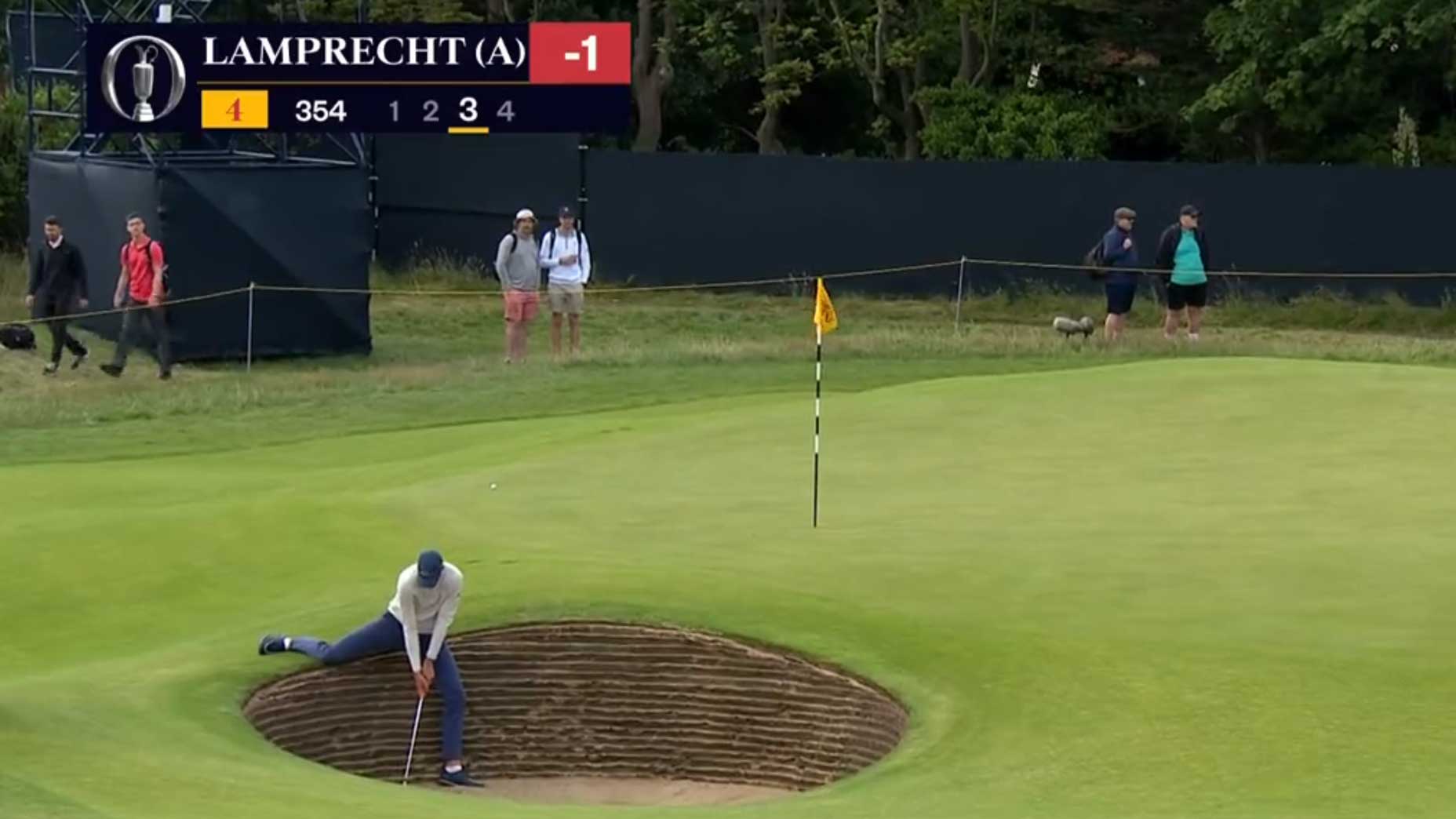HOYLAKE, England — Matthew Jordan has seen Royal Liverpool in every wind, temperature, speed, firmness and condition.
But even he’s never seen it quite like this.
“I haven’t seen the bunkers like this at all,” Jordan said post-round. “I don’t know who’s annoyed the greenkeeper, but yeah — they’re just so flat and they’re so penal. You just can’t hit it in any bunkers whatsoever.”
Flat and penal. You’d think that might aptly describe the bottom of every bunker everywhere, particularly the flat-bottomed pot bunkers of links golf. But there’s a subtle change they’ve made to the bunkers at this week’s Open Championship. And that subtle change makes a big difference.
Typically the bottoms of most bunkers slope towards the middle. That means two things:
- Golfers will hit off an upslope, meaning it’s easier to get the ball elevated
- Balls will roll further from the edge of the bunker, allowing for a better stance and more room to escape.
But not this week. Enter James Bledge, links manager at Royal Liverpool. In an appearance in Iona Stephen’s YouTube channel, On the Road with Iona, the two played the course and he delighted in an explanation of their torturous new challenge.
“We’ll be digging the bowl down to keep it flat so balls run right against the lip,” Bledge says in the video. “In the next few days, we’ll dig down. There are four or five revets hidden under there, and we’ll pull it back so the middle of the bunker will come up a little bit but the edge will be down and you’ll get balls trapped right in.”
Ouch.
As practice rounds wore on players began to better understand the bunker tests that awaited. A common sight at the chipping green has been pros testing awkward lies and trying different strategies for escape. One leg outside the bunker. Both legs outside the bunker. Playing sideways. Backward. Left-handed.
Not everybody was a fan. In his press availability on Tuesday, Scottie Scheffler said he was dreading the thought of finding a bunker.
“I feel like at St. George’s a lot of the bunkers had a tiny bit of an upslope before you got to the wall face,” Scheffler said, referring to the 2021 Open venue. “And here it seems like the faces of every bunker is almost a downslope going towards it.”
Sure enough, Thursday arrived and miserable bunker experiences arrived with it. The reason Jordan is such a reliable witness on the subject is because he’s a member at Royal Liverpool. He owns the course record of 62 and played well in the opening round, too, posting two-under 69 from the first group. He said a bunker shot in the wrong lie could easily cost a player a full shot and perhaps two.
“Both 11 and 15, the bunkers I hit it into, to those pins, it’s normally easy. I would have had no bother, but I did well just to get them both out,” he said. “I’m surprised how harsh they are really, but I guess there you go, it’s links golf.”
Richie Ramsay, a thoughtful Scotsman with an interest in course design, was eager to explain the particular challenge.
“It’s heavily, heavily underrated how much of a difference that makes,” he said of the bunker conditions. “I got caught today on one leg, knee up on the side. It’s just part of links golf. You’ve got to take it on the chin. But you’re very wary of hitting into a bunker knowing that you could be, like, a foot from the face with seven feet in front of you.
“So you’re going to see a lot of guys maybe right up against the face trying to hit it as hard as possible,” he said, citing Jordan’s bunker shot at 11, which he nearly had to play sideways. “I think over the course of a tournament, it’s worth at least an extra shot harder. I would say definitely.”
There’s another difference between typical member play and Open play, too: the bunker rakes. In the same preview video, Bledge explained that a springbok rake is used for day-to-day maintenance, while a hay rake is used for the Open. The difference? The hay rake has “really wide teeth” to quote pro Michael Kim. That leads to tougher lies in the resulting crenelated sand pattern.
The leaders ran into plenty of bunker-related issues on Thursday. Lucas Herbert was T1 when had trouble escaping from the penal bunker right of the 17th green. He wound up making triple bogey.
“I had sort of one foot in the bunker, one foot out,” Herbert said. “In hindsight, it’s very easy to look at it, and maybe even from the stands look at it and go, ‘just get it out onto the green,’ but it just wasn’t as easy as that.”
And early first-round leader Christo Lamprecht drove it into the greenside bunker at the short par-4 fourth — and then contorted his six-foot-eight frame just to escape.
The bunkers make for fun viewing from home. They’re understandably less fun to play. Scheffler, at least as of Tuesday, wasn’t a fan.
“I don’t think that’s something I particularly like in a golf course. I think it doesn’t reward the good shots as much. If you’re closer to the green, you end up closer to the lip, and if you get a worse shot and barely get into the bunker you actually have a play. So I would prefer if there was a little bit of slope there.
“But that’s what’s so special about the majors. Every golf course is different and it’s a challenge, and I’m just going to do my best to stay out of them this week.”
Just stay out of ’em.
Good luck with that.
